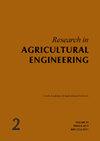Characterisation of briquettes from forest wastes: Optimisation approach
Q3 Agricultural and Biological Sciences
引用次数: 5
Abstract
Waste from a forest environment constitutes an enormous quantity of renewable energy resources. In this study undesirable forest materials, such as jatropha seed shells (JSSs) and Eucalyptus camaldulensis wood shavings (EcWSs) were used in the production of briquettes with Acacia senegal as the binder using mixing proportions of 0 : 100, 25 : 75, 50 : 50, 75 : 25 and 100 : 0 while the binder was varied from 50, 60, 70, 80 to 90 g. Some physical properties, such as the density, moisture content, water resistance and shatter index, were optimised using the response surface methodology at these mixing proportions. The outcome of the production showed the briquettes to have mean values of 0.66 kg·m–3, 11.51, 91.12 and 99.7 % for the density, moisture content, water resistance and shatter index, respectively. The optimum mixing ratio and binder quantity of 75 : 25 and 60 g, respectively, would result in a briquette having a 0.70 kg·m–3, 10.88, 98.11 and 99.86% density, moisture content, water resistance and shatter index, respectively. It has been revealed that the JSS and EcWS are potential organic wastes which could be used as a feedstock for the production of briquettes. It could be concluded that the variation in the mixing proportion of the JSSs, EcWSs and A. senegal significantly affected the properties of the produced briquettes.森林废弃物型煤的特性:优化方法
森林环境产生的废物构成了大量的可再生能源。在这项研究中,使用了不理想的森林材料,如麻风树籽壳(JSSs)和赤桉木屑(EcWSs),以Acacia senegal为粘合剂,使用0的混合比例生产压块 : 100,25 : 75、50 : 50、75 : 25和100 : 0,而粘合剂在50、60、70、80至90g之间变化。在这些混合比例下,使用响应面法优化了一些物理特性,如密度、含水量、耐水性和破碎指数。生产结果表明,压块的密度、含水量、耐水性和破碎指数的平均值分别为0.66 kg·m–3、11.51、91.12和99.7%。最佳配合比和粘结剂用量为75 : 分别为25和60 g的型煤的密度、水分含量、耐水性和破碎指数分别为0.70 kg·m–3、10.88、98.11和99.86%。据透露,JSS和EcWS是潜在的有机废物,可以用作生产型煤的原料。可以得出结论,JSS、EcWS和A.senegal的混合比例的变化显著影响了所生产的压块的性能。
本文章由计算机程序翻译,如有差异,请以英文原文为准。
求助全文
约1分钟内获得全文
求助全文
来源期刊

Research in Agricultural Engineering
Engineering, agriculture-
CiteScore
1.40
自引率
0.00%
发文量
21
审稿时长
24 weeks
期刊介绍:
Original scientific papers, short communications, information, and studies covering all areas of agricultural engineering, agricultural technology, processing of agricultural products, countryside buildings and related problems from ecology, energetics, economy, ergonomy and applied physics and chemistry. Papers are published in English.
 求助内容:
求助内容: 应助结果提醒方式:
应助结果提醒方式:


